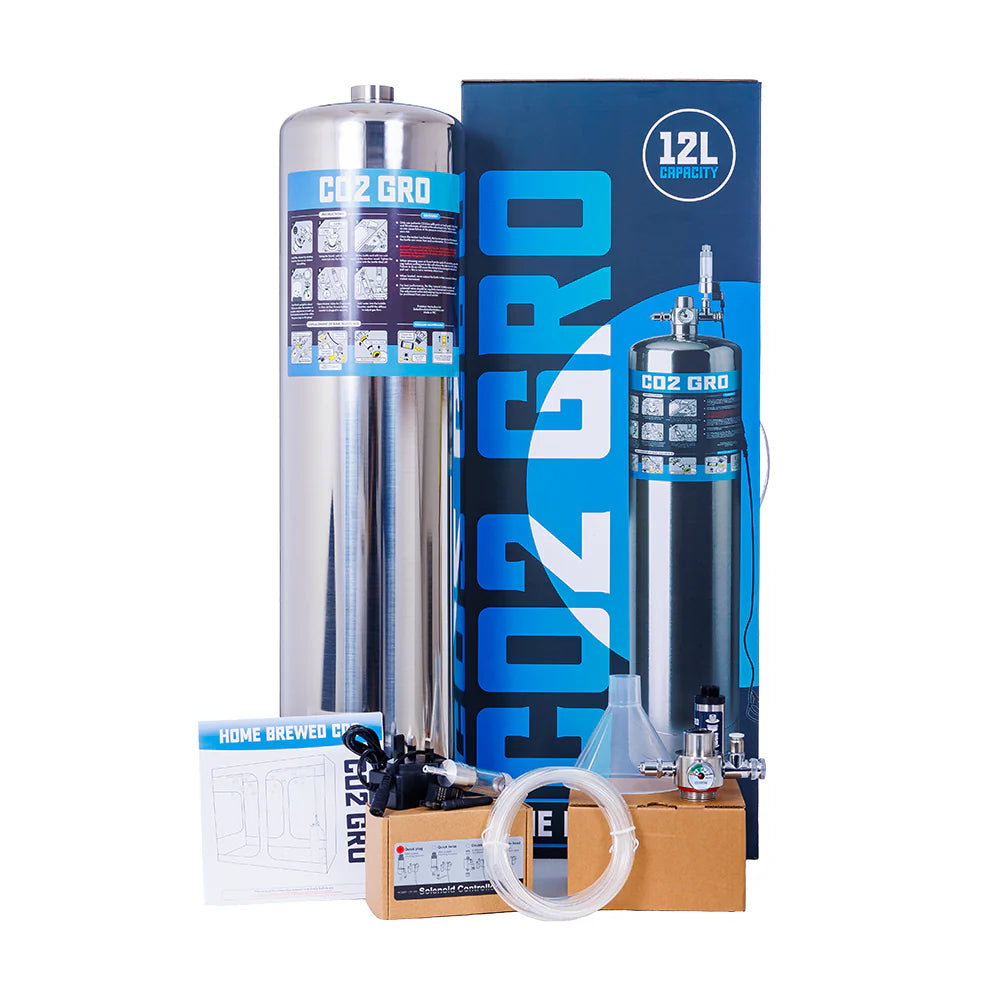
CO2 and Light Levels
The intensity of light at canopy level that you have driving your plant´s growth, is intrinsically linked to the amount of CO2 in its surrounding environment. Meaning if you are giving a lot of one without giving a lot of the other, you could be missing out on some potential un-tapped yield.
Why is each of these things important?
Brace yourself for some science. Don´t be scared.
Photosynthesis is a process in which plants create energy. They do this by turning CO2 from a gas, into a solid from. The gaseous CO2 is taken in by the plant, and converted into a solid sugar used as energy for growth.
The whole process is simplified and explained with the following equation.
Water + Carbon Dioxide ------Light------- Sugar + Oxygen
(H2O) + (CO2) ---Light--- (C6H12O6) + (O2)
This looks like a nice straight forward process right? Unfortunately it´s not quite so simple. It is the result of two processes inside a chloroplast(a cell in the plant), where the ultimate goal is to be as efficient as possible in the production of energy as a whole system.
Each of the two stages are individually responsible for breaking down each of the main inputs: Water and/or Carbon Dioxide to create energy (a sugar). The only true ´waste´ of this process is Oxygen, which us humans fortunately can use to breathe.
The two processes are typically represented with the following diagram.
Right, but what does that mean?
Basically, photosynthesis happens in two stages. One dependant on light levels. One dependant on CO2 levels.
1st stage: Light dependant cycle
By using the water (H2O) and capturing and converting the energy from photons of light , ATP (Adenosine Tri-phosphate) and NADPH (Nicotinamide Adenine Dinucleotide Phosphate) are produced, being essential base ingredients to complete the production of a sugar in the next stage of the process.
2nd stage: Light independent Cycle/Calvin Cycle
This stage of photosynthesis does not need energy from light, and is responsible for turning the once gaseous Carbon Dioxide, into Sugar/energy. Once the sugar is made, the remaining stages of the Calvin cycle produce all the components needed to begin the whole process again.
Interesting, but what does it actually mean?
As the light independent cycle does not need light to continue its function, the production of energy (sugar) is only limited by the amount of ´ingredients´ produced in the light cycle during the day (or the general metabolism of the plant due to temperature at the time – but that is besides the point for now).
It therefore follows that the more of the ´ingredients´ (ATP and NADPH) you can get your plant to make in the first stage (light dependant) of photosynthesis, the more energy(sugar) your plant can make for itself in the second stage (Calvin Cycle). The more energy a plant can make for itself, the more energy it has to put into growth, ultimately leading to a more productive harvest.
Come on man, what really does that actually mean though?
Look at it like a production line consisting of two guys trying to make a thing. The first guy is making an ingredient for the second guy to use, to make the final thing. There´s no point in the first guy making too many ingredients, if the second guy doesn´t have enough final material to process it all with. Like-wise, vice-cersa, there is no point having loads of finishing material for the second guy, if that lazy bastard first guy doesn´t make enough base ingredients for the second to use. They both need to be working relative to each others rate.
But seriously, WTF does that mean?
Basically, you can´t just ramp up your light levels (PPFD) at canopy, without an adequate and relative raise of your CO2 levels alongside it. Well, you can, but you won´t have enough CO2 to even process all that lovely extra light, and you will also likely end up with a bunch of knock-on environmental impacts that result in symptoms of deficiency if you did. Probably resulting in a waste of all that extra light that you just spent all your birthday and Christmas money on.
Oh right, I understand….. so what does that mean then for me?
Well the chances are that if you are using premium LED light technology(like the super awesome DIOTECH lights), and using the equivalent amount of wattage in an area that you previously used with HPS, then you are in this exact scenario.
Premium LED lighting technology will be givin 3.0umol/W, whereas HPS were roughly giving 2.0umol/W. That´s basically half the light again for the same amount of wattage.
So if you took your old 600W HPS light out of your tent and rammed in a swanky 600W LED equivalent, you probably have about 150% of the light that you used to in there. That´s a lot more light for the plant to deal with. Sure would be great to make sure that it could deal with it all eh?
Yeah I get it, but what does that mean?
If you are in elevated light levels then you need to elevate your CO2. Its that simple. How much you need to elevate your CO2 depends on how much you have elevated your light levels. This can be done at most basic level with a calculation of your fixtures total Light output (PPF), compared to your floor space, although getting equipment to measure is a lot better. (Further details of how to accurately measure and control PPFD can be found in further articles)
The following graph represents the sort of raise in CO2 you will need, depending on what sort of CO2 you are delivering. Although anecdotally, there have been instances of people using higher light levels than this with LED lights – these do provide at least a foundation on which to start with.
Right but how?
Yes it does involve buying some new kit most likely. Fortunately for you, there are many ways to skin a cat. Compressed CO2 bottles have their longeveity, but mean awkward frequent replacement of the cylinders. Gas burners often provide unwanted heat and can be a source of carbon monoxide. Fortunately, here at Greenspirit, we have formulated the perfect solution for a hobby grower to brew their own CO2, in the comfort of their own home, negating many of the cons of other CO2 options.
With dedicated controllers that will dose the exact amount you set it to, all you need do is simply refill the canister each time it requires it and your plants will finally make use of every extra photon you can throw at them! Check out the CO2 Home brew kit and dosing equipment here insert link.
Check out the following articles for more information on:
Using LEDS (calculating/measuring PPFD, influencing spectrum etc)
Using CO2: efficient ways to produce and distribute the optimal CO2

